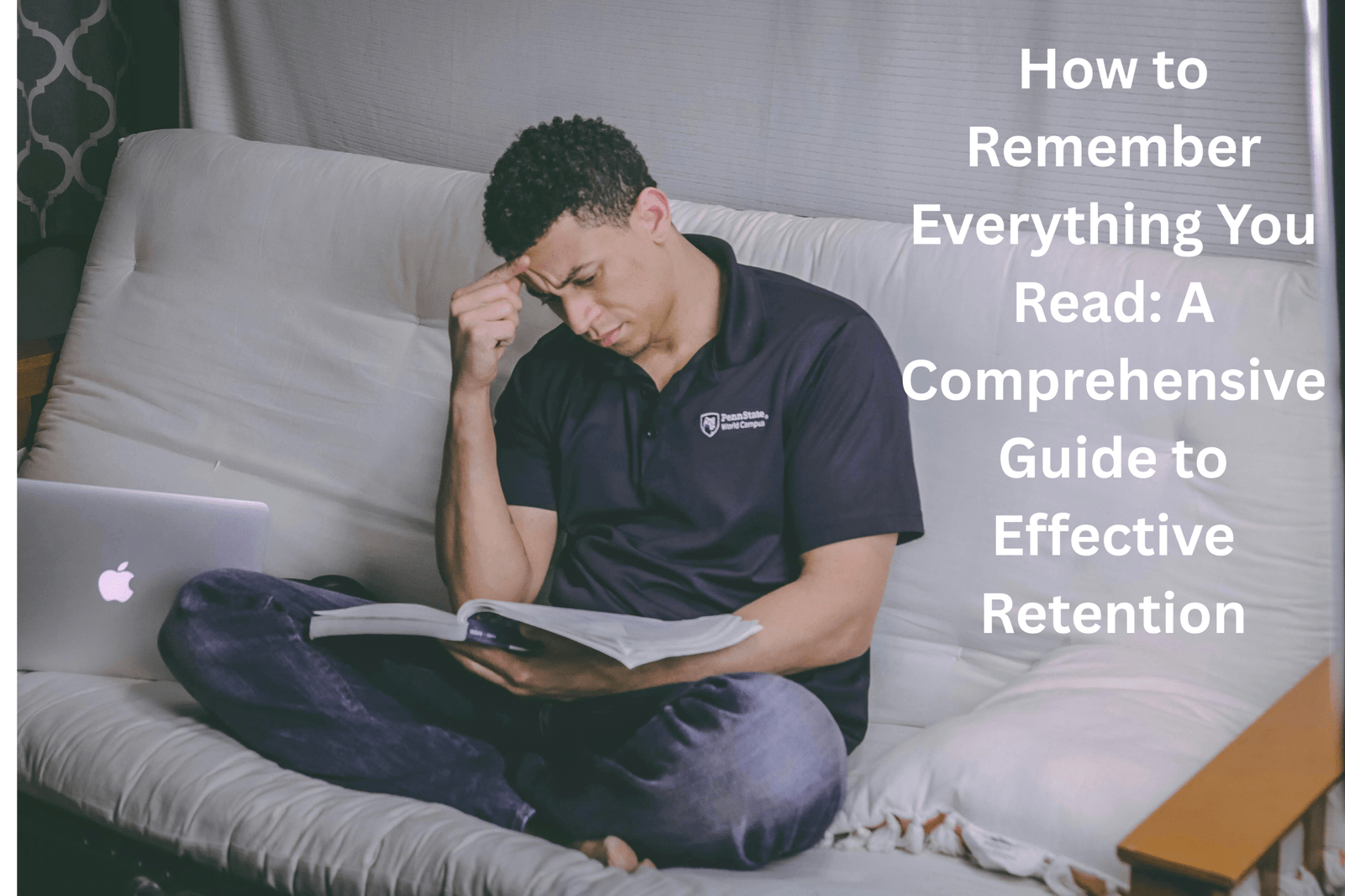How to Remember Everything You Read: A Comprehensive Guide to Effective Retention

Remembering everything you read can feel impossible with the volume of written material presented to us daily. Whether you’re preparing for major exams, learning new concepts for the future, or simply trying to remember valuable information, the ability to retain what you read is essential. So, how can you remember more of what you read?
This article will step through ways to enhance the retention and recall of what you read, to make your study efforts much more effective.
We’ll look at the stages of reading, the Pacer method for pace and retention, and other cognitive strategies to enhance your memory while reading. By the end of the guide, you’ll have specific actionable strategies to begin retaining without any effort!
Stages of Reading: Understanding the Process

Reading is not just about reading down a page and not reading in your head; who can really remember everything? To be able to remember everything you read, it helps to understand the process of reading in clear stages and what that means to you. For a deeper dive, watch How to Remember Everything You Read by Justin Sung , it breaks down memory-based reading strategies that align with this guide.
1. Previewing
Before you read the content, you should really skim through what you are reading for an overview. This first stage of reading is also called previewing and will be set up for your brain and comprehension. Scanning headings, subheadings, and highlighted text is your brain getting set to absorb core concepts.
2. Active Reading
Active reading is when you’re involved with the reading in that you are asking yourself questions and engaging with the text. This means making notes or highlights, or mentally summarizing. Active reading is about absorbing information while you actively process the reading, instead of passively reading.
3. Reviewing
Once you have read the new material, the next step is to review the material you just read. Reviewing the information adds to the strengthening of the neural pathways associated with that information, which will enable your brain to remember the information, and retrieve it when it is needed. You can review at this stage by looking at your notes or recalling the major points from memory. For more tips on optimizing your study technique and using your time efficiently, check out this guide on how to study less and get higher grades.
This phase will not be linear; all of these phases should be a continuous part of your dynamic reading process. Let us take a closer look at how to increase your ability to retain at each of these stages.
The Pacer System: A Simple Memory Tool
The PACER system is a strategy that can help you remember things better. It is a simple, but very effective strategy to improve focus and memory retention when reading. PACER stands for Preview, Active reading, Chunking, Engagement, and Review. Let’s take a look at each step.
1. Preview
Before beginning your reading you should have a preview of the reading. You will want to look for the title, headings, subheadings, bold words, and summaries if they exist. Essentially this is activating your brain to start picking out key information and placing it in context before you begin reading.
2. Active Reading
When reaching the active reading part, you want to be actively engaged, not just passively reading! This is about underlining or lining important concepts, writing a few notes in your own words, and even bubbling questions about the material. When you can engage on a deeper level with material you will digest and retain information better.
3. Chunking
You want to chunk the reading down into manageable smaller parts instead of trying to read through everything at once! Our brains are wired and orthodoxy processes smaller bits of information more effectively – so chunking will help improve focus and memory by reading smaller bits of material. For example, if there is a chapter to read, you could chunk it down into sections or paragraphs to review later.
4. Engagement:
Engagement is important! Ask yourself what you are reading. What is the intent of this passage? How does this fit into what you have learned previously?
Make the material resonate with you personally and make it apply to your life or study, and it will become embedded in your mind.
Deep engagement like this often leads to the state of flow, a psychological state of peak performance, where your focus is effortless and learning becomes more natural.
5. Review:
After you finish reading, review the material. Review your notes, closely inspect your highlighted passages, and summarize the important concepts. This is helpful for retaining information in your long-term memory.
Utilizing the Pacer system when reading will ensure you are not just taking in information but are in fact engaging with the information for retention.
Procedural Memory: Building Long-Term Retention
Procedural memory is a type of memory in your long-term memory where the skills and procedures you have learned are stored. This is what allows you to remember how to perform tasks such as riding a bike, typing on a keyboard, or carrying out a process you have learned.
In terms of reading and study, procedural memory helps with the recall of sequences, steps, and procedures.
To build procedural memory while you are reading, try these tips:
Establish Processes: Develop clear processes for your reading. Your process may involve a preview of the reading, reading a section, taking notes, and summarizing what you read. If you develop the same process, you are retraining your brain to create a map of what you need to know to retain the material.
Practice, practice, practice: The more times you go through a process or a sequence, the easier it becomes for you to remember. By practicing reading one way and reviewing that way, you are strengthening the procedural memory tracks that will help you remember the material you read.
Imagery: One way of reinforcing a procedural memory is linking a chain of procedural information to images in your mind’s eye. For example, you could imagine yourself going through an ordered sequence of steps and see yourself completing each step. This added sensory layer may reinforce your procedural memory.
Analogue Memory: Using Associations to Improve Retention
Analogue memory works by associating new material with something more familiar. Your brain remembers things more successfully when one piece of information is tied to something you already know. The purpose is to build as many analogies and connections as you can to improve your retention.
So, how can you utilize analogue memory in your reading?
Use Common Analogies: Whenever you come across a new concept, think of its relationship to something that you are already familiar with. For example, if you are learning some fundamental principles of economics, you could relate them to the systems of the human body or the members of a sports team.
This is helpful because it helps make the abstract concept more concrete to you, so you can remember it later.
Make Visual Associations: Create visual images or diagrams that relate new information to something you are familiar with previously. For example, you could make a mind map, or simply draw a chart or doodles that help you visualize the relationship of different concepts.
Linking Ideas: While you are reading, look for opportunities to relate new ideas to information you already know. As you read, ask yourself how these ideas relate to what you are currently studying or what you have previously studied, or even experiences you’ve had in life.
Connecting the dots will help you commit the information to your memory.
Conceptual Memory: Understanding the Big Picture
Conceptual memory revolves around understanding the big ideas and themes in the material you read. When you understand the big picture, you will remember the detail more accurately and thoroughly, because the detail is tied to a broad structure of knowledge.
To develop strong conceptual memory, use these strategies:
Focus on Understanding: Instead of saying ‘I need to memorize these facts’, say ‘I need to understand these core ideas’. For example, if you’ve just read a section of history that gave you specific dates and names, try to remember the political, social and economic context of the time, instead of just remembering the dates and names (which are rather arbitrary details).
Summarize it in Your Own Words: Summarize each section in your own words after you read. This forces you to understand the material conceptually, and it helps you to internalize it.
Teach it to Someone: The best way to evaluate whether you understand something conceptually is to teach it. Try to explain what you learned to a friend or family member.
When you are teaching, you have to break down the concepts into more simple language, because the person you are teaching likely doesn’t know the concepts you are assuming they will remember. Teaching this way helps you to realize your level of understanding.
Evidence and Reference: Verifying and Strengthening Retention
Whenever you read, you should also confirm the material you were reading. Using evidence and referencing will confirm your understanding to help retention.
Cross-Check Information: When you read new or complicated material, also cross-check the information with reliable sources. Cross checking will reinforce the material and help confirm information.
Reference Core Texts: When you study, remember the original core texts or reference textbooks. Reviewing the previous texts will deepen your understanding.
Comparing original core texts and different explanations will significantly help your memory, and grow your understanding.
Putting It All Together
You have learned the stages of reading, the Pacer system, and memory processes such as procedural memory, analogue memory, and conceptual memory, and now it is time to pull everything together into a coherent strategy.
Here’s how to do it all:
1. Preview: Your first step is to rapidly skim the text and locate the key relevant sections.
2. Pacing: Next, use the Pacer system of (1) active reading, (2) chunking, (3) engagement, and (4) review – all of which will be related to your final step.
3. Memory Processes: Next, you can engage your memory processes of (1) Procedural, (2) Analogue, and (3) Conceptual memory so you can relate and internalize your information.
4. Check and Review: Finally, obtain second confirmation of your information, and refer back to your key source sources.
By combining the approaches discussed, you can create a structured, effective process to remember everything you read.
Conclusion
It’s not out of the question to remember everything you read. By using great methods such as the Pacer system, with developed procedural and analogue memory, and focusing on the big picture, you can improve how much content you remember when you read. By consistently using these methods as part of your study sessions, you will increase the effectiveness of your study sessions, be able to cognate the information when it is most needed, and thus maximize your learning efficiency. So, what is stopping you from using these methods today?




2 Comments on “How to Remember Everything You Read: A Comprehensive Guide to Effective Retention”